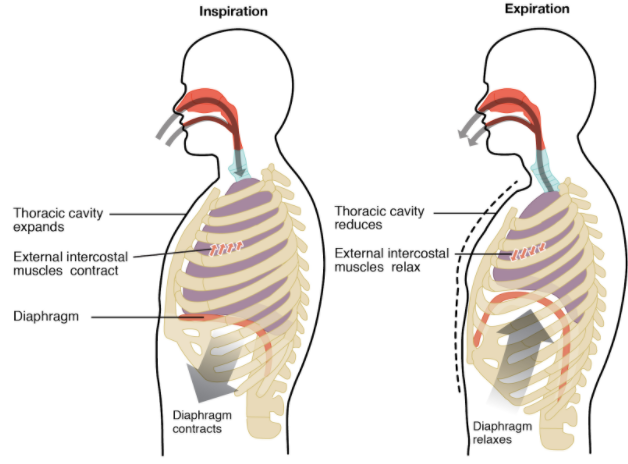
Write the steps in respiration?
Answer
487.8k+ views
Hint: Respiration is the breakdown of complex organic compounds in cell to release simple inorganic compounds and energy. The respiratory system of a human body is made up of respiratory tract and lungs.
Complete answer:
Respiration is an energy releasing catabolic reaction that is controlled by enzymes which involves a step wise oxidative breakdown of organic substances inside living cells. It occurs in all types of living cells even in the ones that are photosynthetic that trap solar energy and store the same in organic compounds.
There are various compounds that gets oxidized at the time of respiration which are known as respiratory substrates. The whole energy that is contained in the respiratory substrates is not released at once. It is released slowly in a step wise series of reaction that are controlled by the enzymes. At the time of respiration, in living organisms oxygen is utilized while carbon-di-oxide, water and energy is released.
According to G.S. Carter respiration is made up of the following stages-
- External respiration/ Pulmonary ventilation is the exchange of gases between lungs and the external environment i.e. we take in oxygen and give out carbon-di-oxide.

- In the alveolar membrane, the diffusion of gases takes place.
- After that gaseous transport through blood happens.
- Carbon dioxide and oxygen between the tissue and blood is diffused.
- Then cellular respiration occurs i.e. oxygen is taken up by cells for the catabolic reaction while carbon-di-oxide is released in the environment.
Note:
- Eupnoea is the state of normal breathing. It is around 12-16 per minute. While in infants it is around 44 per minute. It is the slowest while sleeping.
- Many times when we feel suffocation, this condition in technical terms is called Asphyxia in which either high carbon dioxide or low oxygen concentration occurs.
Complete answer:
Respiration is an energy releasing catabolic reaction that is controlled by enzymes which involves a step wise oxidative breakdown of organic substances inside living cells. It occurs in all types of living cells even in the ones that are photosynthetic that trap solar energy and store the same in organic compounds.
There are various compounds that gets oxidized at the time of respiration which are known as respiratory substrates. The whole energy that is contained in the respiratory substrates is not released at once. It is released slowly in a step wise series of reaction that are controlled by the enzymes. At the time of respiration, in living organisms oxygen is utilized while carbon-di-oxide, water and energy is released.
According to G.S. Carter respiration is made up of the following stages-
- External respiration/ Pulmonary ventilation is the exchange of gases between lungs and the external environment i.e. we take in oxygen and give out carbon-di-oxide.

- In the alveolar membrane, the diffusion of gases takes place.
- After that gaseous transport through blood happens.
- Carbon dioxide and oxygen between the tissue and blood is diffused.
- Then cellular respiration occurs i.e. oxygen is taken up by cells for the catabolic reaction while carbon-di-oxide is released in the environment.
Note:
- Eupnoea is the state of normal breathing. It is around 12-16 per minute. While in infants it is around 44 per minute. It is the slowest while sleeping.
- Many times when we feel suffocation, this condition in technical terms is called Asphyxia in which either high carbon dioxide or low oxygen concentration occurs.
Recently Updated Pages
Why are manures considered better than fertilizers class 11 biology CBSE

Find the coordinates of the midpoint of the line segment class 11 maths CBSE

Distinguish between static friction limiting friction class 11 physics CBSE

The Chairman of the constituent Assembly was A Jawaharlal class 11 social science CBSE

The first National Commission on Labour NCL submitted class 11 social science CBSE

Number of all subshell of n + l 7 is A 4 B 5 C 6 D class 11 chemistry CBSE

Trending doubts
10 examples of friction in our daily life

One Metric ton is equal to kg A 10000 B 1000 C 100 class 11 physics CBSE

Difference Between Prokaryotic Cells and Eukaryotic Cells

1 Quintal is equal to a 110 kg b 10 kg c 100kg d 1000 class 11 physics CBSE

State the laws of reflection of light

Explain zero factorial class 11 maths CBSE




